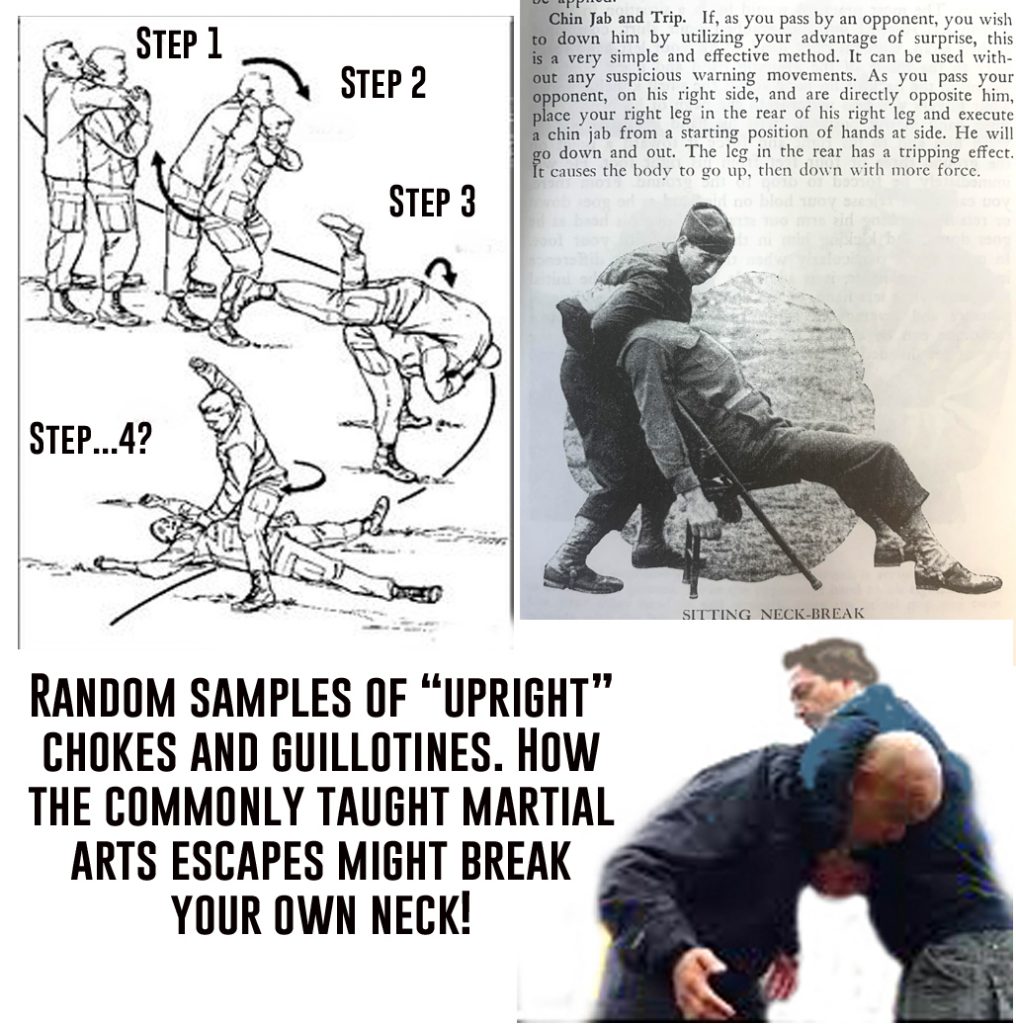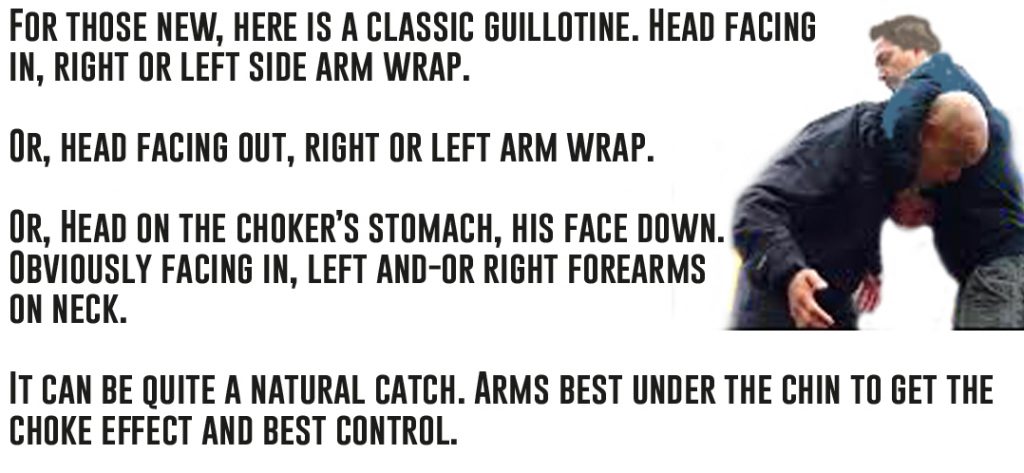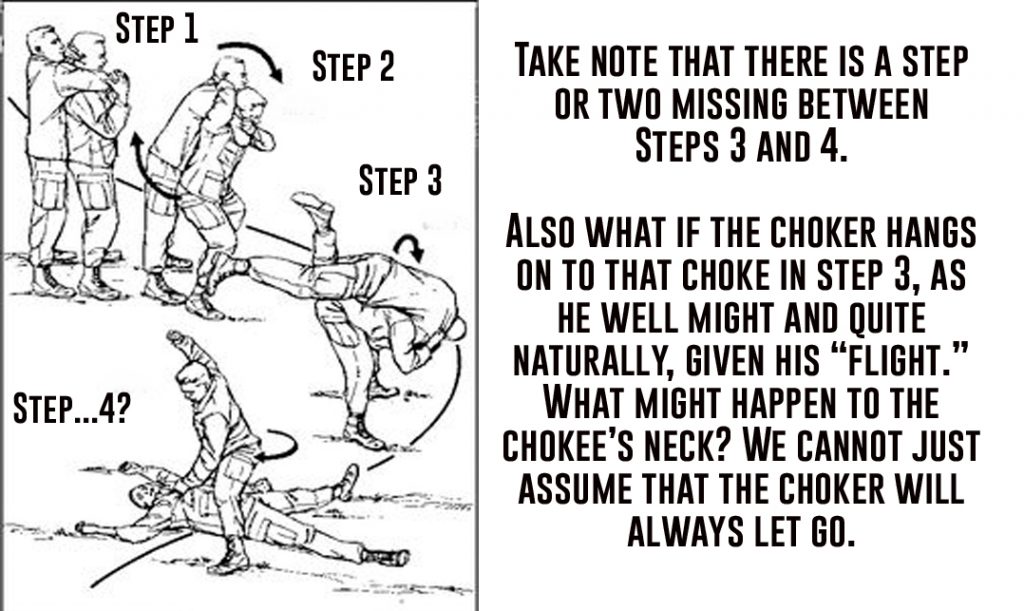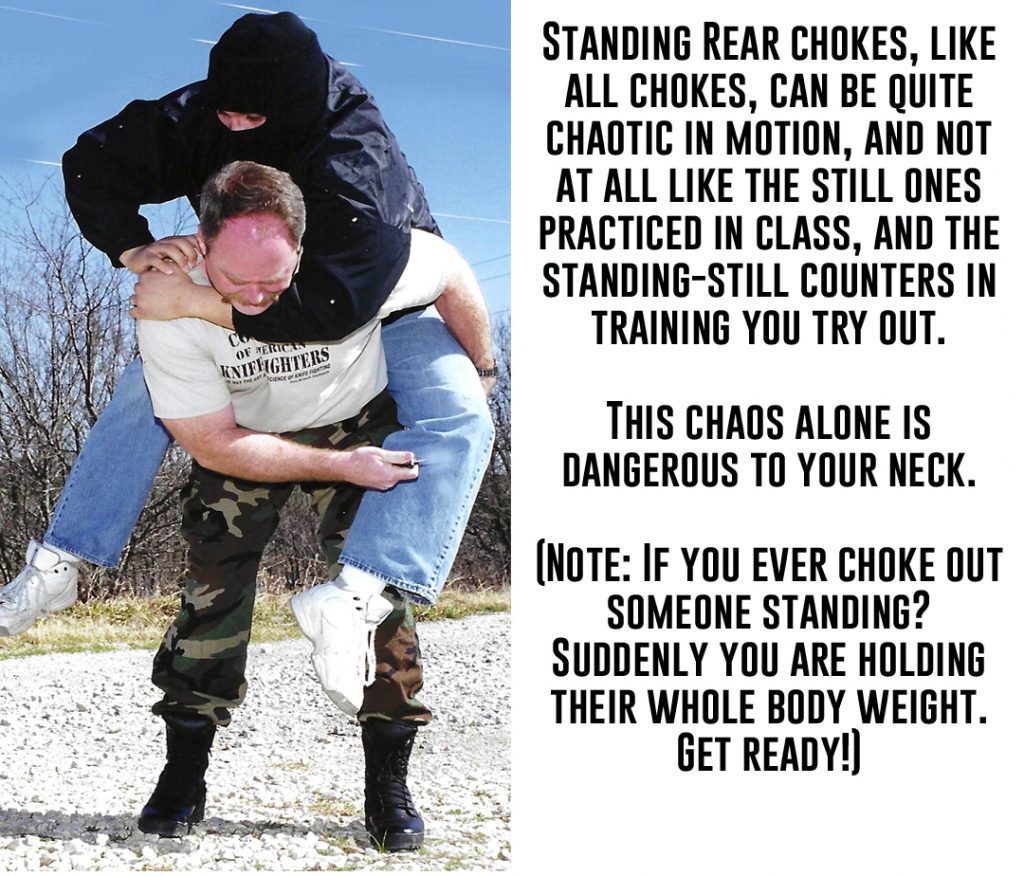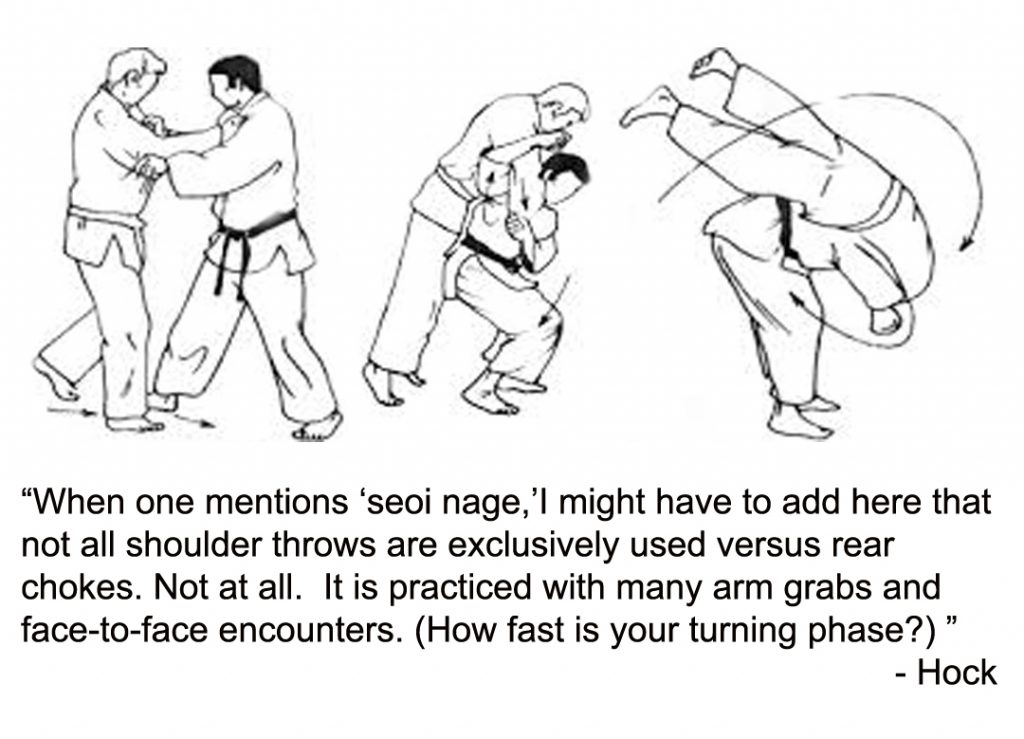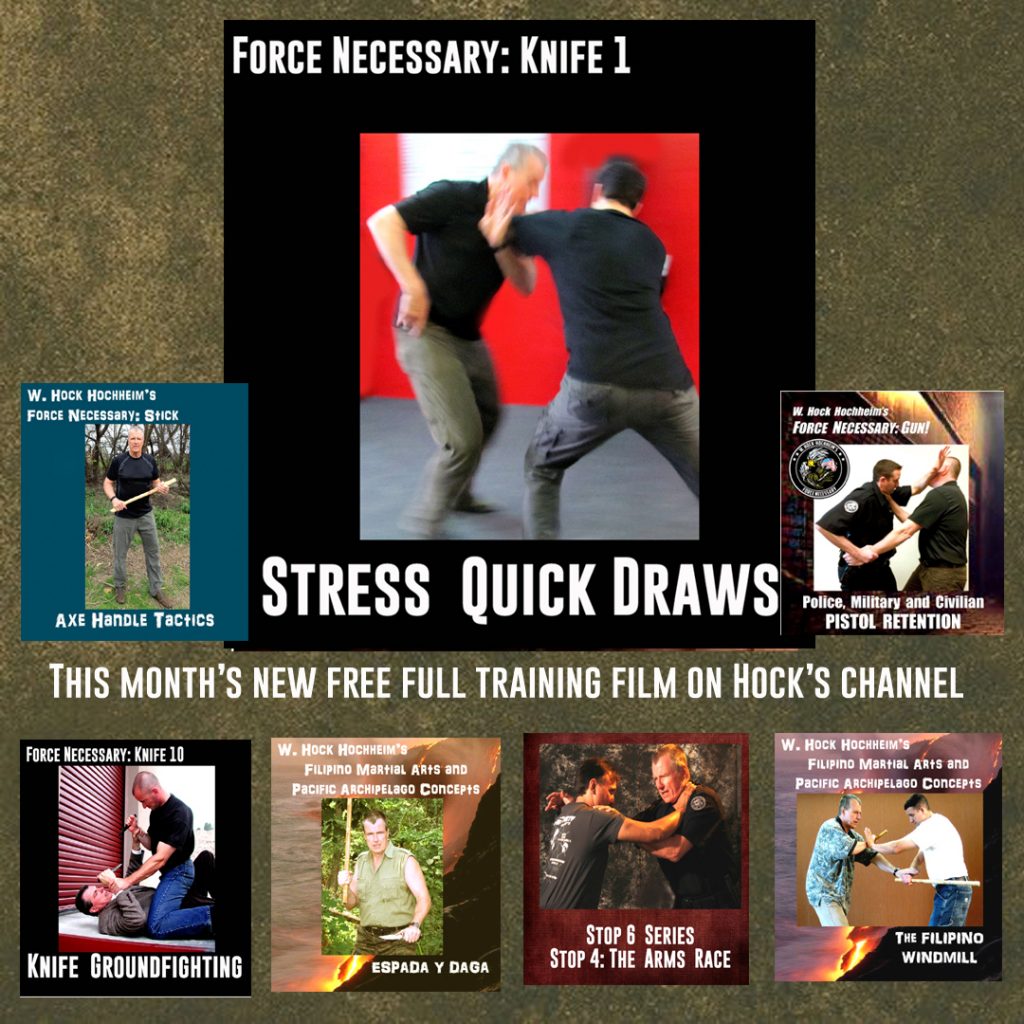From Whiplash to Paralysis.
The Dangers of Escaping Standing Chokes and Standing Guillotines, A Martial and Military Perspective
The world today is innocently obsessed with wrestling (okay, well, actually it’s BJJ with its own special, great mythology and the important, “tribal” uniforms, etc, and which is an addictive, terrific, fun, sport-hobby). And within the grounded, wrestling world, there are about a ton and a half of grounded chokes, cranks and escapes to study. All terrific to mess around with. If you are new to all this then go look the moves up, but most folks, smart enough to be reading this, know what I am writing about.
This essay is NOT about those things on the ground, but rather specifically, ONLY, stand-up neck wraps and some of the classic, dangerous, commonly taught counters to them. This is a safety briefing about the neck and martial studies.
Standing, your neck is grabbed in some sort of arm wrap. But in the arms of an experienced enemy or a stumbling inexperienced rookie, the grabs with a step or a misstep, can quickly damage and even kill you. And worse…with some of the innocently practiced common escapes, you can damn near kill your own self too in the very same ways the bad guy could do it to you. How? It’s all about the neck.
Physio-Life reports that “Even to a completely inexperienced grappler, it would come as no surprise that grappling can be problematic for the neck. In a sport where the aim is to control, strangle and submit your opponent, the neck is often a key pillar in a wide range of attacks…whiplash to permanent paralysis.”
In the study of mixed martial arts “Risk of Cervical Injuries in Mixed Martial Arts” by T Kochhar, D L Back, B Mann, J. Skinner, they list the guillotine drop as one of the 4 most dangerous takedown maneuvers. Dr. Google says – “What does a neck crank do? A neck crank (sometimes also referred to as a neck lock, and technically known as a cervical lock) is a spinal lock applied to the cervical spine causing hyperextension, hyperflexion, lateral hyperflexion, hyper-rotation or extension-distraction. This happens either through bending, twisting or elongating. Neck cranks-locks can cause spinal injuries. Many martial arts prohibit use of this technique given the potential for student injury.” Many do prohibit and of course, many don’t.
What I would like to put under the proverbial microscope here are potential injuries one does to oneself in escaping standing choke chokes and guillotines, as taught by many of the martial arts.
I had the accidental, Youtube experience the other day of watching the Gracie Wonder-Team-Twin nephews run through, oh, like 15 common escapes in 30 seconds from stand-up chokes and stand-up guillotines. My, such experienced, athletic kids the super twins are! They are indeed great, dedicated kids. They live this life daily. Full-timers. I ask quickly – are you? Do you? And yet, about half of the escape moves could get the escapee’s caught neck whip-lashed, broken and-or get them killed, especially the ones where escapees, in layman’s terms, “judo-ize” – flip-throw the chokers’ bodies over them and around into an array of sacrifice takedowns where they both, choker and escapee, happily, willingly, fall down to the mats (not onto the furniture or the hard ground or floors or cement of the real world).
Military Quicker Kills. Rarely taught. Rarely known. Rarely respected. Well, if you flip (or drop down) versus a guy whose got a death grip on your neck? You could hurt or break your own neck. Do most practitioners know how easily the standing choker can kill you, accidentally or on purpose? Or then, how you can damage yourself? It is obvious that these art folks and so many others do not know the list of the old school, rarely-taught-these-days, military quicker-kill, neck breaks. Folks seem to not realize how close their escape moves resemble military neck breaks!
Military Infantry Veteran James Brown adds-writes: “As our host Hock writes: Not many people are taught the really nasty ways to do choke-breaks. In the military, it’s pretty limited to infiltration units. When simply shooting someone in the head with a suppressed weapon isn’t advisable. Or sneaking up and zip tying their neck or stabbing them somewhere isn’t optimal, either. Most knife stuff I learned from military instructors was about sneaking up and making death quiet. A rear choke variation example: Ambush from behind. Arm sinks in around neck. Knee or pelvis lifts targets feet from the ground as second arm sets in. Then a fast and violent body drop by attacker. Target is out in about 3 seconds. Had it done to me. The air lift is critical. It takes away a second of possible response time while allowing a nasty body drop. It can also be done with a rear drag. There are also some front naked choke to neck brake patterns that are basically: One of these 6 breaks should work or buy time to get to a knife.”
These martial arts escapes can work so well “in the dojo” demos and training because:
- it’s only learning-training.
- both parties know what is going to happen.
- There is no radical, chaotic motion that accompanies a real grab.
- the martial chokers know how to roll, go with the flow and protect the escapees’ necks as choker is flipped.
- the choker loosens-lets go of the trapped neck at a key moment to save his partner’s potential neck damage.
- even in freestyle, the trained choker remembers what to do, “not to break the rules.”
- when necks are legally caught tight enough, those caught know when to tap, even when standing, and they remain standing once tapped.
Rough Necks. Serious MMA and wrestler competitors’ necks can take a brutal beating. These are dedicated “pros,” are awesome athletes, and most both stretch and work on neck strengthening exercises. Neck strength is well known to be critical! Serious wrestlers have serious necks. Do you? Probably me – no, your instructors – no, your average military – no, police – no, the citizen taking self-defense courses – no. We will be in the 99.99999% percenters that are NOT thick-necked, professionals. (Still, “big” necks or not, there are plenty of “pro” neck injuries with takedowns and wrestling on the mats.)
Killing the Neck! These Military Neck Breaks. In the big picture, unarmed military combatives in general was and is rarely taught to the military. The in-the-field military is a weapons-based, explosives-based, equipment-based, teamwork-based world and very little time is spent on the one-versus one, unarmed topic in comparison to these other vital, more probable topics. This training time, prioritizing reality goes all the way back to the Samurai.
Why are the “military neck killers” somewhat ignored in the military? In a name-game twist, many militaries call anything close-up as “hand-to-hand combat” even with close-in weapons versus weapons. Still lots to do with weapons, just very close-in. Within today’s military combatives, neck breaks are still rarely taught percentage-wise. The methods exist of course if you can find them. Also, insiders know that for many recent years now, the militaries of the world have been hypnotized into a sport, martial arts priority. Plus, there is a real underlying mission-mandate for safe training (!) – not to get the troops hurt in any training, lest of all in the rare, short, combatives training courses.
Still, unless you are capturing a prisoner for interrogation, the military needs to kill the enemy as quickly as possible, and should you get a hold of his neck, you kill him there. There are many quicker ways to kill someone with neck grabs. For example, once a neck wrap or a choke is obtained, the choker can jump-drop back, forward or to the side and pretty much “kill-crack the neck” of the caught enemy. Needless to say a citizen or a cop fighting for their life would need these quicker kills too for survival. Briefly they are:
- choker crushes windpipe (this will take a bit longer).
- choker very suddenly, violently does situational-positional-directional snapping wrenches and yanks.
- choker suddenly does situational-positional body drops.
- other than in war, the choker had better be, logically, explain-ably, understandably in fear of their life to execute these moves. Or play dumb?
- these can happen with stumbling mistakes in training and sports.
It would be smart for all to learn the military quicker kill ones for critical self-defense, yes. And no matter who you are, learn them also so as to avoid the possible mishaps in training. And when taught escapes and counters to this problem, you must assess these moves to see if they are indeed dangerous to your neck and your people’s necks.
These same devastating moves can happen accidentally in class, in competitions and real world fighting when you don’t seek such severe body damage and death, to your drunk friend or relative. Or, to someone you are arresting! (There are numerous accidental and incidental neck injuries and deaths in police work. You know this from the news.) Unlike in some advertised courses, not everyone you scuffle with is a Nazi commando to be executed!
Solutions to these standing choke-neck problems is a Training Mission 5, Stop 5 problem, neither of which I have filmed or written yet in book chapter form, like a chapter in a TM 5 book with 40-50 photos or more. It will be (I am only amassing TM 3, Stop 3 right now). Can’t do it all here. I got the outlines. Come to a seminar.
By the way, holding a blood choke for too long, standing or ground can be deadly. “How long can the brain survive without oxygen? There is no one-size-fits-all answer to this question. For example, if the brain is receiving a limited supply of oxygen, it can survive longer than a brain receiving no oxygen. According to Medicine Plus a resource of the U.S. National Library of Medicine: “Brain cells are very sensitive to a lack of oxygen. Some brain cells start dying less than 5 minutes after their oxygen supply disappears. As a result, brain hypoxia can rapidly cause severe brain damage or death.”
Oh and lastly and again? Size and strength really does matter, especially when you are flippy-dippy, tossing people around. I know the esoterics like to say they don’t matter, but they matter. As with clothing, “one size does not fit all.”
All martial training can be dangerous. We persevere. I am not and you are probably not a full-time, 5 days a week, “Wonder Twin” – so take a hard look at standing choke and guillotine escapes “out there,” and in your classes. I am only suggesting that when presented with martial moves in and around the neck, see how they might be dangerous and see how many flippy, counter throws, takedowns and ground crashes could damage your neck and the necks of all those non-professional, non-super, non-wonder-twin athletes that you know, which is probably, just…about…everyone.
- Ways to strengthen your neck – https://www.airrosti.com/mma-neck-injuries/
- 10 Exercises-Ways Boxers can Develop Strong Necks (good for all combat sports) https://evolve-mma.com/blog/10-neck-strengthening-exercises-for-boxing/
_______________________________________________
A Weeks Later, An Addendum: This essay is only about safety issues concerning grappling in and around the neck, and how some of the often suggested escapes might be neck-dangerous especially to the new and medium trained people. This is not about ALL “Judo”-BJJ-wrestling-grappling, not working.” This essay was dispatched a lot of places, very well-sheared, re-shared with thousands of likes. Very well-received. But a rare few hyper-sensitive, hyper-defensive people just “blew up.” Instantly they distort this safety issue and ignorantly leapt to protect their overall, “wrestling,” superiority when obviously, partially reading this essay and jumping to ignorant conclusions. I then, of course am an untrained idiot, a fake with no grappling experience.
Why do I think a bit about the neck? Some of my personal experiences, four for examples.
- First: As explained in the essay, I am just not fond of Seoi Nage, the shoulder throw, the over the shoulder throw versus the standing choke. One time, experimenting in class, years ago, being 6’2” I have been grabbed by a 6’7”-er, working on this throw with a big heavy-set, guy and when I dropped a bit, butt extended back, to start this off, he repositioned and he “refused” to bend over. And the blood choke on me only increased. I essentially “hung there” in a worse choke than before. He chuckled. His size and weight and my size and weight absolutely mattered. Plus, I do have trouble with this move versus shorter people too. Height and weight-size is always an issue. (And a strong hesitation to turn my back to an opponent.)
- Second: In South Korea in the 70s, I was tricked, and jumped from behind with that single arm wrap choke. He pushed the small of my back, then leapt backwards. He landed on his chest and fortunately for me, I landed on my side, NOT on my back because I am sure he would have broken my neck. We ended up in a north-south sort of position (on a frozen muddy, village road.) I escaped this by breaking his pinky, of all things, which he let go right away at the snap. I later knew this was a trained move, I’d seen it before somewhere and later found it in a 60s, 70s military combatives manual, back then called the “Ranger Takedown.” It is a neck-breaker. A killer! I was very lucky. My left side was severely bruised and sore from that frozen ground landing the next day. Oh, and my neck really hurt. I am not suggesting that all muggers know the Ranger Takedown, but I started thinking that chaotic moves and drops could hurt the neck. Drops like this (or accidental falls) could be dangerous to the neck.
- Third: Teaching many years ago in Delaware, I was showing a frontal takedown, a pull-down. A classic. You kick and-or strike the guy to bend over, then grab his neck in a Thai-style forearm-like, clinch. Then yank him face down while stepping back. Since I had spent time with a Chin Na Chinese guy, one thing he showed us was a wavering, side-to-side, of locks and cranks, which really enhanced a bunch of them. In this pull-down, if you yank-jerk the head side-to-side in the takedown, it really accentuates the pull-down. I showed this application, THEN I warned everyone not to do this! For not even half-real, because of the neck damage. If so, try it once in very slow-motion. Well, two guys walked off to their corner, and did it too hard and too fast. The uke guy dropped to the floor, and…knocked out, had some sort of a spasm-seizure fit. Luckily, there was an EMT there training with us, and he took over. It looked really bad. The guy recovered but nis neck was killing him. He was done for the day, sat on the floor pale-faced and watched. He was a no-show on Sunday.
- Fourth: In 26 years of police work, I have only choked out, oh maybe…9 or 11 people. Not many at all. The blood choke. Some of them were on the ground – as on floors (well, one was atop a couch and a coffee table, we were flat but not on the official ground-ground) and some standing. People snake around when neck-grabbed and the blood choke intent can become the wind-pipe choke by accident and they are the subject of many injuries and even death law suits. So much so, many (if not most) police agencies have disallowed ANY such neck contact, blood choke or otherwise. Holding these blood chokes for too long is also dangerous. A lot of this info is above, in the essay.
- Fifth. Of note, a long-term neck injury. A well-known, international martial instructor (to name one) is getting a stint in his windpipe, having had it partially crushed and crushed too much in all kinds of training for many a year.
Anyway, my only point is – there are safety issues with neck grappling. In a world of early-phase, mid-phase and late phase, counters-escapes, there is little chance of late phase, choke escapes. Plus, research shows plenty of neck injuries exist. This is why I think about the neck and martial arts training.
_________________________
Hock’s email is Hock@SurvivalCentrix.com
Check out Hock’s free, full feature training videos, a new one each month at- click here
